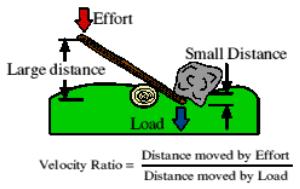Velocity Ratio: Difference between revisions
From DT Online
No edit summary |
(Added Template) |
||
| (4 intermediate revisions by the same user not shown) | |||
| Line 1: | Line 1: | ||
[[File:MechanismsVelocityRatio.jpg|300px|right]] | [[File:MechanismsVelocityRatio.jpg|300px|right]] | ||
__TOC__ | |||
=====Description===== | |||
Sometimes, mechanisms are used to translate a small amount of movement into a larger amount ''(or vice versa)''. | Sometimes, mechanisms are used to translate a small amount of movement into a larger amount ''(or vice versa)''. | ||
| Line 8: | Line 11: | ||
This property is known as the [https://en.wikipedia.org/wiki/Gear_ratio '''Velocity Ratio (VR)'''], and is calculated by dividing the distance moved by the '''effort''' by the distance moved by the '''load'''. | This property is known as the [https://en.wikipedia.org/wiki/Gear_ratio '''Velocity Ratio (VR)'''], and is calculated by dividing the distance moved by the '''effort''' by the distance moved by the '''load'''. | ||
In an ideal world, the Velocity Ratio of a mechanical system would be numerically equivalent to its Mechanical Advantage - i.e. we ‘pay’ for being able to raise a large load by applying effort over a large distance. Machines are not 100% efficient however, there are losses due to wear and tear, friction, heat and noise for example, and so we do not ‘get out’ quite as much as we ‘put in’. The ''' | |||
=====Features and Applications===== | |||
In an ideal world, the Velocity Ratio of a mechanical system would be numerically equivalent to its '''[[Mechanical Advantage]]''' - i.e. we ‘pay’ for being able to raise a large load by applying effort over a large distance. Machines are not 100% efficient however, there are losses due to wear and tear, friction, heat and noise for example, and so we do not ‘get out’ quite as much as we ‘put in’. | |||
The '''[[Mechanical Efficiency|Efficiency]]''' ''(or inefficiency!)'' of a mechanical system can therefore be calculated by dividing its '''[[Mechanical Advantage]] (MA)''' by its '''Velocity Ratio (VR)''' and then multiplying by 100 to get a percentage - i.e. '''Efficiency = MA/VR x 100%''' | |||
{{Construction Kits Buyers Guide}} | |||
[[Category:Secondary]] | |||
[[Category:Mechanisms]] | [[Category:Mechanisms]] | ||
[[Category:Terminology]] | |||
Latest revision as of 20:11, 3 September 2016
Description
Sometimes, mechanisms are used to translate a small amount of movement into a larger amount (or vice versa).
For example, in a high gear on a bicycle, one revolution of the pedal crank causes several revolutions of the bicycle wheel. Conversely, a car jack requires a lot of movement of the handle to lift the car just a short distance.
This property is known as the Velocity Ratio (VR), and is calculated by dividing the distance moved by the effort by the distance moved by the load.
Features and Applications
In an ideal world, the Velocity Ratio of a mechanical system would be numerically equivalent to its Mechanical Advantage - i.e. we ‘pay’ for being able to raise a large load by applying effort over a large distance. Machines are not 100% efficient however, there are losses due to wear and tear, friction, heat and noise for example, and so we do not ‘get out’ quite as much as we ‘put in’.
The Efficiency (or inefficiency!) of a mechanical system can therefore be calculated by dividing its Mechanical Advantage (MA) by its Velocity Ratio (VR) and then multiplying by 100 to get a percentage - i.e. Efficiency = MA/VR x 100%
|
Click top left to enlarge |









